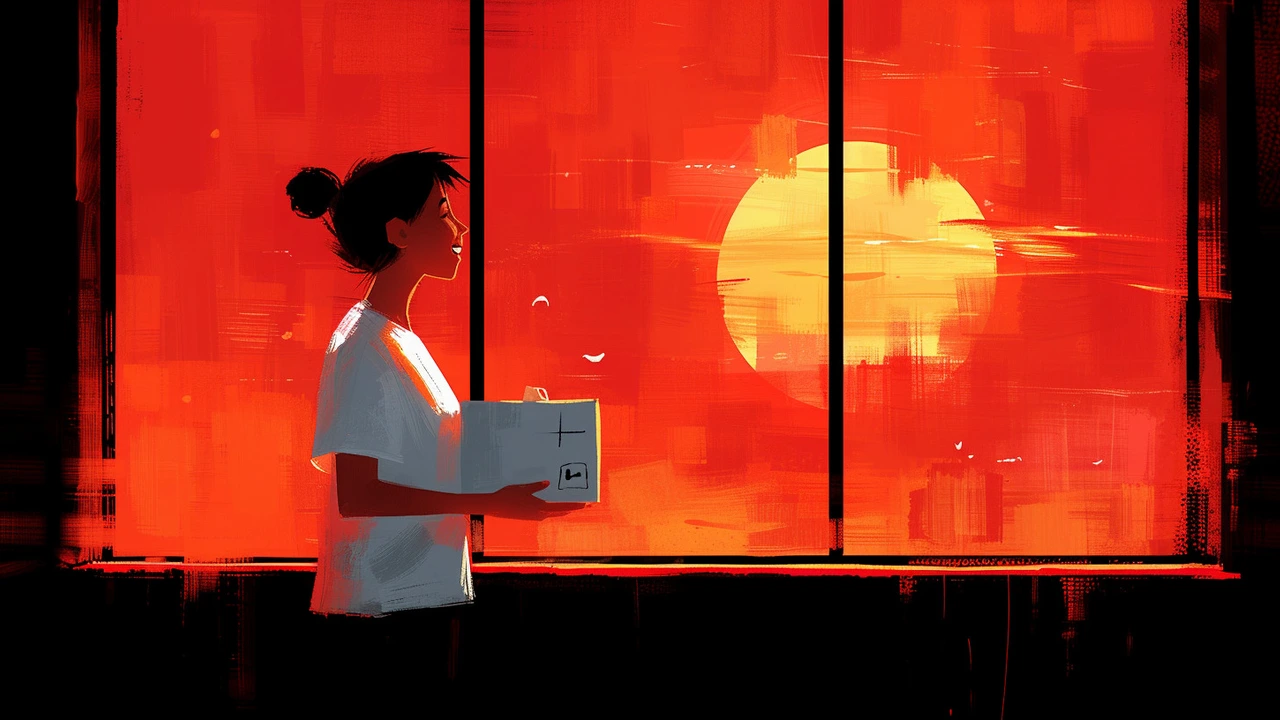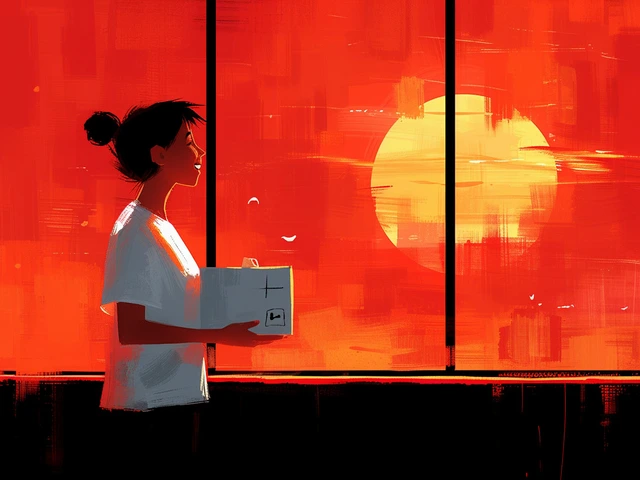The Lure of Minimalism: What's the Big Deal?
Minimalism. It's a concept that's as sleek and appealing as a freshly wiped smartphone screen, yet has the depth and complexity of a Russian novel (sans the length, obviously). You see it tousled across Pinterest like salad greens in a hipster café, but what's all the fuss about? Well, friends, I'm here to unravel the allure of minimalism and possibly coax you into its cozy, decluttered embrace. So, imagine your life with less 'stuff' to worry about. Feels nice, huh?
I can hear your murmurs and see your dubious faces. What does living with less mean, Loretta? It's like trying to tell someone the taste of water—you kinda have to experience it. But I'll give you the cliff notes: Minimalism means different things to different folks, but the core idea is simplicity. It’s bidding farewell to consumerism's sneaky whispers and adopting a life where less is definitely more. Sounds a bit zen garden, doesn't it?
Now, before you think I'm writing this from a stark white room with a single piece of furniture, let me assure you, minimalism isn't about stripping your home or life to a bare minimum (unless that tickles your fancy). It's about creating more room for joy, peace and breathing space. I mean, isn't it always a tad more cheerful to chill in a space that doesn't scream 'help me, I am drowning in a sea of unopened mail and mismatched socks’?
And this isn't just me waxing poetic about minimalism. Studies suggest that clutter can genuinely affect your brain's ability to concentrate and process information. So when I say decluttering might make you feel better, there's science backing me up! And who am I to argue with brainy scientists? I’ll leave the brainy to them and will stick with the 'feely' and personal experience part. Speaking of experiences, let's glide into the practicalities, shall we?
Minimalism Is a Mindset, Not Just Empty Space
Alright, let’s deal with the elephant in the room, which in this case, isn't an actual elephant but the preconception that minimalism is just about physical 'stuff'. When you first dip your toes into minimalism's clear waters, you'll quickly realize this lifestyle is a mindset shift. It's about perception and intention—considering things with purpose and meaning rather than compulsive hoarding or thoughtless accumulation. In essence, it's thoughtful ownership.
Now, when I started my minimalism journey, I had to fight the urge to go gung-ho and toss out everything that wasn’t nailed down. But pause and breathe. Minimalism isn't about removing joy or living in a state of perpetual ‘I may need this someday’. It’s about knowing what adds value to your life and letting go of what doesn't. It's quality over quantity—like having one fabulous, heart-skipping cheesecake slice instead of a bunch of 'meh' ones.
For me, the mindset thing kicked in when I realized that I was buying the third set of string lights not because I needed them, but because they were on sale and 'ooh, pretty'. It’s the curse of the discount label, I tell you. So, before the next purchase, I started asking myself, "Do I love this? Will I use this?" I know, real groundbreaking, Loretta. But you’d be surprised how often the answer was "Nope" followed by a swift pirouette away from the checkout counter.
Minimalism also helped me recognize that my time and energy are precious resources—not something to be buried under cleaning, organizing, and managing the hoards. Ask yourself this: would you rather spend hours dealing with stuff or chuckling with friends, frolicking outdoors, or unwinding with a treasured book? (Heads up: if that book is War and Peace, you might need a spot of unwinding after, too.)
Benefits Galore: Why Strip Down Your Life?
Now, I know y'all are thinking, "Sure, Loretta, selling us the dream, but dish out the specifics." Challenge accepted. Let’s talk turkey—or tofu, if that’s your jam. Aside from the nirvana-like peace you may find in a clutter-free zone, there are practical benefits that'll make even the most skeptical of skeptics nod approvingly.
For one, there’s the money aspect. Embracing minimalism means you're more deliberate with your purchases. Say goodbye to those impulse buys that end up gathering guilt dust in the corner. Money not spent on the fleeting thrill of shopping sprees can be saved or splurged on experiences that sketch lifelong memories. Trust me, you’ll smile more reminiscing about that kayaking trip than the novelty egg slicer that's lost in your kitchen drawer.
Then there's stress. Or should I say, less of it. A minimalist approach can lead to a decrease in cortisol, the stress hormone that has a habit of overstaying its welcome. Fewer things mean less to clean, less to organize, and a lesser chance of losing your mind trying to find your keys in the morning. In my case, it also means fewer hide-and-seek sessions with Jules who, by the way, has a knack for camouflaging among fluffy pillows and scarves.
And don't even get me started on the freedom and flexibility minimalist living affords. Without the gravitational pull of stuff to chain you down, moving becomes a walk in the park instead of a logistical nightmare. Minimalism can also be an eco-friendly high five to Mother Earth—buying less means less waste and a smaller carbon footprint.
But here's the kicker: the time you reclaim. Ah, sweet, sweet time. When you're not trapped in an exhausting cycle of acquire-clean-store-repeat, you get to choose how you spend your hours. Pick up a hobby, learn a language, or surf your couch cushions—whatever tickles your pickle.
Creating Your Minimalism Game Plan: Where Do I Even Start?
Alright, let's get down to brass tacks—or should I say, brass minimal tacks (pun absolutely intended). Thinking about sipping the minimalist cocktail but not sure where to start? Here's a roadmap to embark on your less-is-more lifestyle, complete with scenic spots and a no-rush policy.
First things first, don’t aim for a Pinterest-worthy home overnight—it's not a sprint, folks. Take it thing by thing, drawer by drawer. Start small, perhaps with a single shelf or your wardrobe. My first nugget of advice? Tackle those items you're indifferent to. Yes, I’m talking about the 'I-guess-it’s-okay' home décor or the 'it-serves-a-purpose-I-guess' gadgets. If it doesn’t spark joy or utility, it’s time for it to find a new home.
Set yourself a goal. It could be a daily item count to bid adieu to or a single space to declutter each week. For the sentimental souls, it's fine to keep things that hold emotional value—minimalism isn’t heartless, after all! Just remember, if you’re keeping it, make sure it’s cherished and not just cluttering up your space.
Also, don't hesitate to unfollow retailers or unsubscribe from promotional emails that tempt you to buy more. Out of sight, out of mind, out of your shopping cart. Oh, and take five before any purchase. In those moments, I ask myself critical questions like "Will I use this?" and "Where will this live in my house?" It’s amazing how a pause can prevent a plethora of needless stuff.
It's a journey—not a magical 'Poof! You're a minimalist!' moment. There'll be stumbling blocks and possibly a U-turn or two, but that's okay. Every item you repurpose, donate, or say no to, is a step towards a minimalist lifestyle. Baby steps, big impact.
Decluttering Techniques That Could Put Marie Kondo to Shame
Now hold onto your hats, because we're diving into the thrilling world of decluttering techniques. Before you yawn or click away to check your horoscope, stay with me—these methods might just be the thing you need to conquer your cluttered castle.
There's ‘The Four-Box Method’—keep, donate, sell, trash. This one's a classic, like a good ol’ apple pie but for your closet. Anything you haven't worn in a year? In the donate or sell box, it goes. Damaged beyond repair? Alas, it's trash. It's a methodical way to sift through stuff without getting overwhelmed.
‘The Minimalist Game’ is fun, especially if you rope in a friend or family member. On day one, ditch one thing. Two things on day two. Keep this up, and by the end of the month, you're less 465 items! Sounds intense, I know, but it's a wild ride and quite the revelation on how much we can let go of—like a minimalist rollercoaster, but with less screaming.
Or try the ‘One In, One Out’ rule. It's simple: whenever a new item walks through your door, an old one takes a hike. It keeps your stuff in check and prevents accumulation. It’s like maintaining equilibrium in your personal ecosystem without the need for David Attenborough's narration.
These techniques help to break down the monumental task of decluttering into manageable, bite-sized pieces. A decluttered space eventually leads to a decluttered mind, and who doesn't want that? I mean, we’re not trying to give Marie Kondo a run for her money, but if we happen to come close, that's not a bad thing, right?
Surfacing Past the ‘But What If I Need It?’ Hurdle
It's the mantra of every would-be declutterer turned hoarder: "But what if I need it?" Oh, how this little sentence has saved many a gadget from their destined journey to the donation box. But it's exactly this mindset that keeps us shackled to our mountains of stuff.
Now, let's clear the air—I'm not saying you should toss out your spare tire because it hasn't seen daylight in a year. Some items rightly deserve their 'just in case' status. But that novelty candle holder shaped like a pineapple? Let's be real.
Here's my trick: if I'm on the fence about an item, I put it in a box with a date marked on it. In six months, if I haven't opened the box to retrieve the item, chances are I don't need it. The box takes a little trip to a charity or a selling app, and voilà—more space and less stuff to worry about!
Also, think about it this way: how often have you truly, honestly, desperately needed an item after getting rid of it? Odds are, rarely. And even if such a unicorn moment arises, borrowing or inexpensively repurchasing the item is typically feasible. It’s about assessing true needs versus imagined scenarios where you're suddenly in dire need of that fourth colander.
Solidifying Your Minimalist Habits for the Long Haul
So you've cleared out the clutter, breathed the minimalist air, and tasted the simplicity stew. Well done! But as with any lifestyle shift, the key is sustainability. Remember, minimalism isn’t just a spring clean—it’s an ongoing commitment.
Maintaining your newfound minimalist bliss means routinely reassessing your belongings. The change of seasons, birthdays, or any milestone can be a nifty reminder to survey your stuff. A periodic purge makes sure you don’t backslide into old habits. Habituation, my fellow journeyers, is the guardian of your minimalist temple.
Another tried and tested tactic is continued mindfulness with purchases. Resist the glossy lure of consumerism. Those shiny ads with smiles and sparkles? See them for what they are—tantalizing traps. Before you click 'buy', envision where the item will live in your home. If you can't picture a place for it or its role in your life, step away from the cart. Think of it as a little dance: two steps forward with meaningful acquisitions, and no steps back.
And remember, minimalism isn’t punishing. It’s not a club where you get your minimalist membership revoked for owning more than a prescribed number of items. It’s a flexible, personal path. What looks minimal for me might not match your version of minimalism—and that’s a-okay. Find your happy medium, the point where your lifestyle feels streamlined but not spartan, and nurture it.
Embracing the Change and Enjoying Your New Space
Well folks, we've traversed the peaks and valleys of beginning a minimalist lifestyle together. If you've decided to give it a whirl, I'm cheering you on like the enthusiastic basset hound mom that I am (Jules sends his droopy-eyed support too).
Once you’ve cleared the clutter and your home starts to echo with the lovely sound of more space (alright, not literally, unless you're into yodeling), take the time to enjoy it. Savor the simplicity, the ease, and the calm. It's a bit like enjoying a homemade cookie without the distraction of packaged sweets—it's just wholesomely better.
Your home becomes a sanctuary, a place that supports your well-being and reflects your values. The objects you choose to keep around are your curated collection of joys and utilities. They serve you, not the other way around. And that feeling, my dears, is more refreshing than a splash of cool water on a sweltering Dallas day.
In embracing minimalism, you might just find that you've not only created more physical room in your home but psychological room in your life for growth, peace, and contentment. So go ahead, explore what living with less can mean for you, make your own rules, and enjoy the journey. After all, life isn't about the stuff we collect, but the experiences we gather and the dogs we pet along the way.
And on that note, I'll bid you adieu and go give Jules a well-deserved belly rub—he's been patiently awaiting his usual afternoon cuddle amidst all this writing frenzy. Till next time, happy decluttering, and remember—less can truly be more.



Leave a Comments